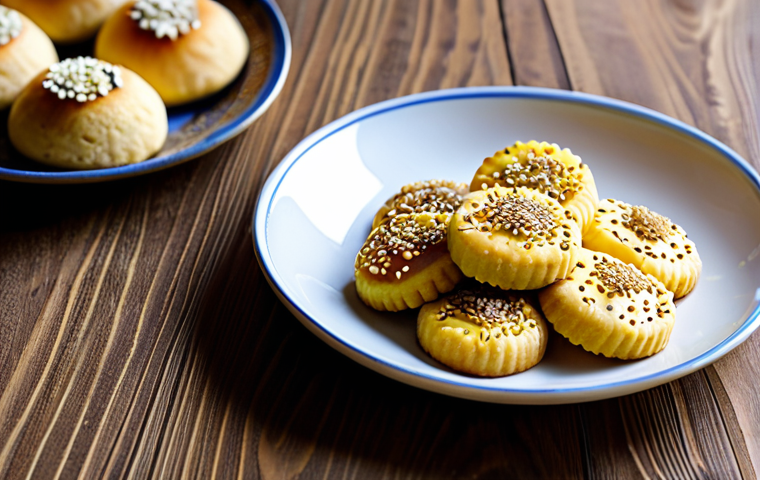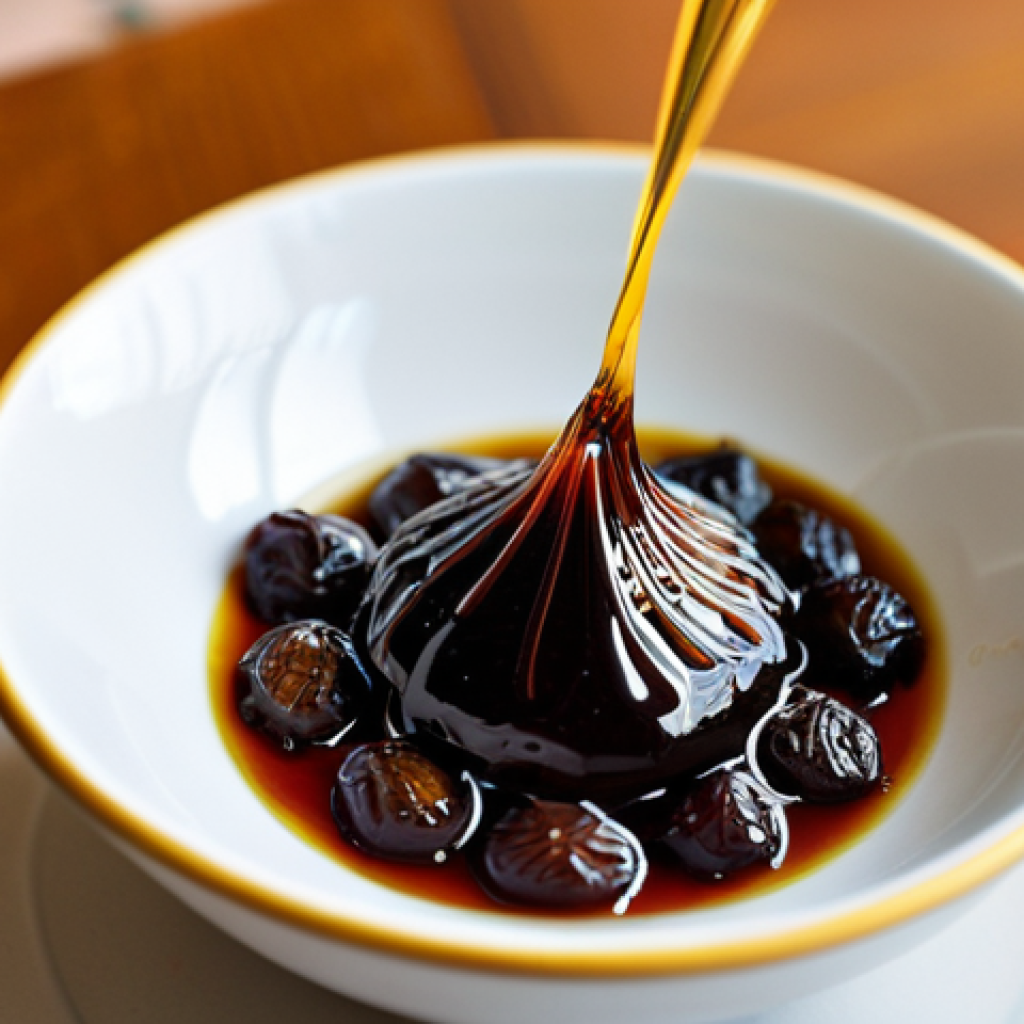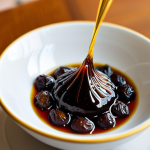Kuwait, often celebrated for its stunning architecture and bustling markets, holds a deliciously guarded secret that often goes unnoticed by the casual visitor: its extraordinary world of traditional desserts.
As someone who’s had the genuine pleasure of exploring the culinary landscape here, I can tell you firsthand that the sweet treats are far more diverse and enchanting than you might imagine.
My own expectations were completely shattered during my first culinary adventure – I anticipated familiar Middle Eastern staples, but what I discovered was an intricate tapestry of unique flavors and textures that felt deeply authentic and utterly delightful.
This isn’t just about satisfying a sweet craving; it’s about tasting history, wrapped in exquisite spices and innovative techniques. You see, these aren’t static recipes; they are living traditions, subtly evolving, sometimes even getting a contemporary twist to appeal to new generations or gain global recognition, much like we’re seeing with viral food trends on platforms worldwide.
The future of these timeless sweets seems incredibly bright, as more and more people discover their unique charm beyond the region. Let’s explore it accurately.
The Golden Bites of Hospitality: Luqaimat’s Enduring Charm

Stepping into a Kuwaiti home, or even just wandering through a local market, you’re almost guaranteed to encounter the tantalizing aroma of Luqaimat. For me, it was love at first bite – these aren’t just mere fried dough balls; they are tiny, spherical vessels of pure joy, encapsulating centuries of culinary tradition. I vividly recall my first encounter during a visit to the historic Souk Al-Mubarakiya. The sight of a vendor deftly dropping spoonfuls of batter into sizzling oil, the golden spheres bobbing and hissing, was mesmerizing. The magic truly happened when they were drizzled generously with date syrup, known locally as ‘dibs’, or sometimes a sugar syrup infused with saffron and cardamom. The experience is more than just eating; it’s a sensory journey, from the crisp crackle as you bite into the golden-brown exterior to the yielding, airy softness within. It feels like a warm hug, a sweet welcome that instantly makes you feel at home. This dessert, simple in its components yet profound in its effect, speaks volumes about Kuwaiti generosity and the deep-rooted culture of sharing food.
The Crispy Exterior and Soft Interior: A Symphony of Textures
What sets Luqaimat apart, in my personal opinion, is that exquisite textural contrast. You get that satisfying initial crunch, almost like a thin candy shell, which then gives way to an incredibly soft, spongy interior. It’s a delicate balance that perfectly absorbs the sweet, aromatic syrup without becoming soggy. I’ve tried many variations across the region, but Kuwaiti Luqaimat often strikes this balance flawlessly. It’s not overly dense, nor is it hollow; it’s just perfectly puffy. The dough itself, often enriched with a hint of yeast and sometimes a touch of yogurt, ferments just enough to create those delightful air pockets that make each bite so utterly light and satisfying. It’s truly remarkable how such a seemingly simple preparation can yield such a complex and delightful mouthfeel, leaving you reaching for just one more, and then another, until the plate is mysteriously empty.
Beyond the Syrup: Flavors that Tell a Story
While date syrup is the classic accompaniment, the subtle flavors baked into Luqaimat themselves are what truly elevate them. You’ll often find whispers of saffron, lending a delicate golden hue and an almost ethereal floral note, alongside the warm, spicy embrace of cardamom. These aren’t overpowering; they’re harmonious undertones that dance on your palate. I remember a particularly memorable batch I had, where the saffron was so perfectly balanced, it just enhanced the natural sweetness of the dough. It made me realize that these aren’t just random additions; they are carefully chosen spices with historical significance, echoing the ancient spice routes that once crisscrossed this region. Each bite feels like a small taste of history, a connection to generations of Kuwaitis who have perfected this beloved treat.
Saffron-Kissed Delights: Kuwait’s Aromatic Cakes and Puddings
Moving beyond the fried wonders, Kuwait also boasts an incredible array of baked goods and puddings that showcase a more refined side of its dessert tradition. One that consistently steals my heart, and frankly, my appetite, is Gers Ogaily. It’s often referred to as Kuwaiti saffron cake, but that description hardly does it justice. This isn’t your average fluffy sponge cake; it’s a moist, dense, and incredibly aromatic masterpiece, deeply infused with the golden essence of saffron and the comforting warmth of cardamom and rosewater. It typically gets decorated with a sprinkle of toasted sesame seeds, adding a delightful crunch and nutty finish. I first tried Gers Ogaily at a traditional family gathering, and the moment the delicate aroma hit me, I knew I was in for something special. It felt celebratory, a dessert truly meant for sharing on special occasions, yet comforting enough for an afternoon tea. The vibrant yellow hue from the saffron is just as appealing to the eye as the flavor is to the palate, truly a feast for all senses.
Gers Ogaily: A Cake Steeped in Tradition
Gers Ogaily is more than just a cake; it’s a symbol of Kuwaiti hospitality and a staple at gatherings, Eid celebrations, and weddings. The recipe, passed down through generations, often features a unique method of preparation where the eggs are whisked for an extended period, contributing to its distinctive airy yet substantial texture. My local Kuwaiti friend once shared that her grandmother always insisted on grinding fresh saffron threads and cardamom pods just before baking, believing it made all the difference – and honestly, having tasted her grandmother’s version, I can wholeheartedly agree. The rich, almost earthy notes of the spices blend seamlessly with the subtle sweetness, creating a complex flavor profile that lingers beautifully on the tongue. It’s a cake that embodies patience, precision, and a deep respect for culinary heritage, a truly heartwarming experience with every slice.
The Versatility of Saffron in Kuwaiti Confectionery
Saffron, the world’s most expensive spice, plays a starring role in many Kuwaiti desserts, and its use in Gers Ogaily is a prime example of its transformative power. Beyond just adding color, it imparts a complex floral, slightly honey-like aroma and a subtle earthy bitterness that balances the sweetness. I’ve also noticed it in other local sweets, from delicate biscuits to rich milk puddings. Its presence elevates a dish from merely sweet to truly sublime. This spice is a testament to the historical connections of Kuwait with global trade, and how ingredients from far-flung lands became integral to local cuisine. It speaks volumes about the value placed on quality ingredients and the dedication to crafting desserts that are not only delicious but also visually appealing and deeply fragrant. It’s truly a cornerstone flavor in Kuwaiti sweets, and once you start noticing it, you realize just how deeply ingrained it is in the culinary identity.
Sweet Whispers of the Sea: From Grains to Glee
Kuwait’s dessert landscape also offers a fascinating glimpse into how humble grains can be transformed into dishes of profound comfort and unique flavor. Balaleet, for instance, might sound simple—sweet vermicelli—but it’s a dish that masterfully blends sweet and savory notes, a concept I found utterly intriguing and surprisingly addictive. It’s often served for breakfast, and I remember my initial skepticism at the idea of sweet pasta for my morning meal. However, one bite changed everything. The thin vermicelli noodles are cooked with sugar, saffron, and cardamom, and then often topped with a delicate omelet. This combination creates a delightful contrast: the fragrant, sweet noodles are grounded by the subtle saltiness and richness of the egg. It’s a testament to the ingenious way local ingredients are combined to create something truly distinctive and satisfying, proving that dessert can absolutely be a versatile dish enjoyed at any time of day.
Balaleet: A Breakfast Staple, A Sweet Sensation
Balaleet is more than just a dish; it’s a morning ritual for many Kuwaiti families. The preparation is straightforward, yet it requires a delicate touch to ensure the vermicelli remains separate and doesn’t clump together. I was taught by a local chef that the secret lies in toasting the vermicelli lightly before boiling it, which gives it a slightly nutty flavor and prevents it from becoming mushy. The aroma that fills the kitchen as the saffron and cardamom infuse into the cooking noodles is simply intoxicating. The addition of the plain or lightly seasoned omelet on top provides a much-needed savory counterpoint, making each spoonful a balanced experience. It’s a dish that embodies simplicity and warmth, perfect for starting the day with a gentle sweetness and a hearty touch, a true comfort food that transcends typical breakfast boundaries.
Khabeesa: Warming Hearts with Every Spoonful
Another beloved grain-based dessert that offers immense comfort is Khabeesa. This sweet dish, made from roasted flour or semolina, dates, and often ghee, is a richer, heartier treat, especially popular during cooler months or as an energy booster. Its texture is almost like a very thick, dense porridge or a soft cake, deeply imbued with the caramel-like sweetness of dates and the nutty richness of the roasted grain. I vividly remember trying Khabeesa during a slightly chilly evening. The warmth and the comforting spices felt incredibly soothing, like a hug in a bowl. It’s less about delicate flavors and more about robust, wholesome goodness, providing a sustained sense of satisfaction. It’s a reminder that Kuwaiti desserts aren’t always light and airy; some are designed to be substantial, nourishing, and deeply satisfying, echoing the region’s historical reliance on nutrient-dense ingredients.
Dates: The Unsung Heroes of Kuwaiti Sweetness
You cannot speak about Kuwaiti desserts without dedicating a significant section to dates. These humble fruits are not just a snack; they are a fundamental building block of the local culinary identity, and their versatility in desserts is truly remarkable. From being a natural sweetener to providing the very core of a dish, dates are woven into the fabric of Kuwaiti sweet traditions. My personal journey through Kuwaiti sweets revealed just how integral dates are, not just as an ingredient, but as a cultural symbol. They represent sustenance, hospitality, and a connection to the land. You see them everywhere, from simple platters of fresh dates offered to guests to complex, elaborate desserts where they take center stage. The sheer variety of date-based treats reflects the deep appreciation for this natural bounty.
Rangina: A Date Pudding of Profound Depth
Rangina is a prime example of dates being transformed into a luxurious dessert. This rich, date-based pudding is incredibly comforting and surprisingly decadent. Made from soft, mashed dates, often mixed with butter or ghee, and then spiced with cardamom, cinnamon, and sometimes nutmeg, it’s typically garnished with toasted nuts like walnuts or pistachios. The first time I encountered Rangina, its appearance was deceptively simple, yet the depth of flavor was astonishing. It has a sticky, almost fudge-like consistency, and the sweetness of the dates is beautifully complemented by the warm spices. It’s a dessert that feels ancient and authentic, a true reflection of the desert landscape’s enduring gifts. I find it particularly satisfying during cooler evenings, as its richness provides a comforting warmth that feels deeply nourishing.
Innovative Date Creations: Beyond the Traditional
While traditional date desserts like Rangina hold a special place, it’s fascinating to see how modern Kuwaiti chefs and home bakers are innovating with dates. Beyond just stuffing them with nuts or cheese, I’ve seen dates being incorporated into contemporary cakes, tarts, and even ice creams. There are now date-flavored chocolates, date power bars, and even date spreads that have become popular. This evolution showcases a wonderful balance between preserving culinary heritage and embracing new culinary trends. It reflects a dynamic food scene that isn’t afraid to experiment while staying true to its roots. It’s exciting to witness how this humble fruit continues to inspire new generations of culinary creators, ensuring its place at the heart of Kuwaiti sweets for years to come.
| Dessert Name | Primary Ingredients | Key Flavor Profile | Common Occasion/Serving Style |
|---|---|---|---|
| Luqaimat | Flour, Yeast, Sugar, Saffron, Cardamom, Syrup | Sweet, Crispy exterior, Soft interior, Aromatic | Ramadan Iftar, Gatherings, Afternoon Tea |
| Gers Ogaily | Eggs, Flour, Sugar, Saffron, Cardamom, Rosewater, Sesame Seeds | Moist, Aromatic, Delicate, Spongy | Eid, Celebrations, Special Occasions |
| Balaleet | Vermicelli, Sugar, Saffron, Cardamom, Eggs (optional) | Sweet, Fragrant, Often with savory contrast from egg | Breakfast, Light Meal |
| Rangina | Dates, Butter/Ghee, Flour, Cardamom, Cinnamon, Nuts | Rich, Sweet, Earthy, Fudge-like, Spiced | Special Occasions, Winter Months, Family Gatherings |
| Khabeesa | Roasted Flour/Semolina, Dates, Ghee, Spices | Hearty, Sweet, Dense, Comforting, Caramelized | Cooler Weather, Energy Boost, Dessert |
Crispy Wonders and Melt-in-Your-Mouth Marvels
Beyond the well-known staples, Kuwaiti dessert traditions are rich with a variety of textures and experiences that often surprise and delight. There are sweets designed for melting in your mouth and others for providing a satisfying crunch, each with its own story and place in the local culinary tapestry. My explorations led me to discover several lesser-known, yet equally captivating, delights that truly showcase the breadth of Kuwaiti ingenuity in confectionery. It’s like discovering hidden gems in a treasure chest, each one offering a unique sensory experience. From delicate shortbreads that crumble with the slightest touch to intricate fried pastries, there’s a world of texture and flavor waiting to be explored that goes far beyond the initial, more famous few.
Ghrayba: The Buttery Bliss of Shortbread
Ghrayba is a perfect example of a melt-in-your-mouth marvel. These shortbread cookies are deceptively simple, often made with just flour, sugar, and an abundance of clarified butter (ghee), sometimes flavored with rosewater or cardamom. What makes them so special is their incredible tenderness; they literally dissolve on your tongue, leaving behind a rich, buttery sweetness. I recall being offered these delicate cookies with a cup of traditional Arabic coffee, and the combination was pure bliss. The subtle bitterness of the coffee perfectly cut through the richness of the Ghrayba, making it an incredibly satisfying pairing. They are often served at celebrations and family gatherings, a testament to their comforting and universally loved appeal. It’s a sweet reminder that sometimes, the simplest ingredients, when handled with expertise and care, can create the most profound pleasures.
Zalabya: Twisted Delights for Every Palate
While similar to Luqaimat in being fried dough, Zalabya offers a distinct experience. These are often larger, sometimes irregularly shaped or twisted, fried dough pieces that are typically soaked in a sugar syrup. What I find fascinating about Zalabya is its rustic charm and often chewier texture compared to the airy Luqaimat. It embodies a more homely, unrefined appeal, yet is equally satisfying. I remember watching a street vendor prepare these, the dough being stretched and twisted almost rhythmically before hitting the hot oil, creating beautifully imperfect spirals. The joy of pulling apart a warm, syrupy piece of Zalabya is something truly unique. It’s a testament to the variety within Kuwaiti fried dough desserts, proving that there’s more than one way to enjoy a sweet, crispy, syrup-laden treat, each with its own character and charm.
The Evolution of Sweetness: Modern Twists on Timeless Classics
While the reverence for traditional Kuwaiti desserts is palpable, it’s equally exciting to witness how the culinary scene is evolving. There’s a vibrant energy in Kuwait, a willingness to innovate and adapt, without losing sight of the precious heritage. This fusion of old and new is particularly evident in the world of sweets, where classic recipes are being given contemporary twists, attracting new generations and even gaining international recognition. I’ve seen cafes and specialized dessert shops experimenting with traditional flavors in unexpected ways, much to the delight of patrons. It’s a clear sign of a dynamic food culture that respects its past while eagerly embracing the future. This adaptability ensures that Kuwaiti desserts remain relevant, exciting, and continue to captivate palates both locally and globally.
Fusion Flavors: Bridging the Old and New
One of the most thrilling aspects of Kuwait’s evolving dessert scene is the emergence of fusion flavors. Imagine a classic Ghrayba cookie infused with an unexpected twist like pistachio cream or rose petal jam, or a modern rendition of Balaleet served as a deconstructed dessert in a fine-dining setting. I’ve personally tasted Gers Ogaily cupcakes, retaining the saffron and cardamom notes but presented in a portable, contemporary form, and even Luqaimat flavored with unique spices or dipped in chocolate. These innovations are not about abandoning tradition but enriching it. They introduce beloved local flavors to new formats and techniques, making them more accessible and appealing to a broader audience, including those who might be new to Middle Eastern cuisine. It’s a delightful culinary dialogue between generations and cultures, leading to exciting new taste experiences.
The Role of Social Media in Sweet Preservation
Social media platforms have played a pivotal role in the preservation and popularization of Kuwaiti desserts. From vibrant food blogs showcasing traditional recipes with step-by-step guides to viral videos of modern dessert creations, the digital landscape has become a powerful tool. I’ve noticed a significant uptick in interest, both locally and internationally, fueled by stunning visuals and engaging content that highlights the beauty and deliciousness of these sweets. This digital exposure not only introduces these desserts to a global audience but also encourages younger Kuwaitis to learn and appreciate their culinary heritage. It creates a community around food, fostering both a love for timeless classics and an excitement for innovative interpretations. It’s a fascinating example of how technology can help keep traditions alive and thriving in the modern age, ensuring the sweet legacy continues.
Concluding Thoughts
My culinary journey through Kuwaiti sweets has been nothing short of enchanting. Each bite, from the crispy delight of Luqaimat to the comforting richness of Rangina, tells a story of hospitality, heritage, and an unwavering love for flavor.
It’s a testament to a vibrant culture that values sharing and celebrates life’s sweet moments. So, whether you find yourself wandering through a bustling souq or enjoying a quiet afternoon tea, I wholeheartedly encourage you to dive into the wonderful world of Kuwaiti desserts.
You won’t just be tasting delicious treats; you’ll be experiencing the heart and soul of Kuwait.
Good to Know
1. Where to Find Them: The best places to experience authentic Kuwaiti desserts are local markets (souqs), traditional bakeries, and especially during visits to Kuwaiti homes, where hospitality shines brightest. Specialized dessert shops often offer modern twists too.
2. Pairings are Key: Many Kuwaiti sweets, particularly the richer ones like Rangina or Ghrayba, are traditionally enjoyed with a small cup of bitter Arabic coffee (Qahwa) or hot tea. The coffee’s boldness perfectly balances the sweetness.
3. Seasonal & Occasional Delights: While many desserts are available year-round, certain ones like Luqaimat are particularly popular during the holy month of Ramadan for Iftar (breaking fast), and others like Gers Ogaily are staples at Eid celebrations and family gatherings.
4. Fresh is Best: For fried items like Luqaimat and Zalabya, they are at their absolute peak when served warm and fresh. Don’t hesitate to try them from a street vendor for the most authentic experience.
5. Sweet Souvenirs: Cakes like Gers Ogaily and cookies like Ghrayba make excellent take-home gifts, as they travel well and retain their flavor for a few days, allowing you to share the taste of Kuwait with loved ones.
Key Takeaways
Kuwaiti desserts are a rich tapestry of flavors, textures, and traditions. They prominently feature foundational ingredients like dates, saffron, and cardamom, reflecting the region’s history and culinary heritage.
From deep-fried doughs to aromatic cakes and comforting grain-based dishes, the variety is vast. These sweets are deeply intertwined with Kuwaiti hospitality, often served as a welcoming gesture or during special occasions.
The modern culinary scene also shows an exciting evolution, with chefs blending traditional flavors with contemporary presentations, ensuring these beloved treats continue to thrive and delight new generations.
Frequently Asked Questions (FAQ) 📖
Q: What sets Kuwaiti traditional desserts apart from other Middle Eastern sweets I might be familiar with?
A: My first thought here is the sheer unexpected variety. Coming from a background where I thought I knew Middle Eastern sweets – baklava, kunafa, you name it – Kuwait just blew those expectations out of the water.
It’s not just about the typical syrup-soaked pastries; there’s a distinct lightness to some, an incredible depth of spice in others, and a surprising use of ingredients you might not see as commonly elsewhere in the region.
Think about how ghuraiba just melts on your tongue, or the subtle rosewater perfume in a perfectly crafted balaleet. It’s less about one dominant flavor profile and more about a delicate balance, a unique dance of local ingredients that truly feels distinct.
Trust me, it’s a whole different ballgame.
Q: You mentioned these aren’t static recipes. How are Kuwaiti dessert traditions evolving, and how can a visitor experience this blend of old and new?
A: That’s such a brilliant point, because I’ve seen it firsthand. These aren’t just museum pieces; they’re very much alive. You’ll still find the grandmothers meticulously preparing luqaimat the way they have for generations – that’s the heart of it.
But then, walk into some of the newer, chic cafes or even high-end patisseries, and you’ll see a clever chef taking a classic, say, asabe’ al-arous, and presenting it with a modern twist, maybe a different sauce or a lighter texture.
It’s not about abandoning tradition, it’s about innovation rooted in heritage. To experience it? Absolutely hit up the local souqs for the authentic, rustic charm, but don’t shy away from those contemporary spots either.
You get to taste history being made, truly.
Q: For someone visiting Kuwait for the first time, where’s the best place to start tasting these extraordinary desserts, and what’s one must-try you’d recommend?
A: Oh, this is where the fun begins! Honestly, my first stop would always be the traditional souqs, like Souq Mubarakiya. The aroma alone is intoxicating, and you can usually find small, unassuming stalls selling incredibly fresh, authentic bites.
Don’t be afraid to just point and try! Beyond that, local bakeries and even some of the larger, established sweet shops will have a fantastic selection.
If I had to pick just one to start with, something that truly captivated me, it would have to be Zalabia. It’s a fried dough, often infused with saffron, and typically served with a drizzle of syrup.
The texture, the warmth, the subtle spice – it’s just pure comfort and a perfect introduction to that unique Kuwaiti sweetness. Just talking about it makes my mouth water!
📚 References
Wikipedia Encyclopedia
구글 검색 결과
구글 검색 결과
구글 검색 결과
구글 검색 결과
구글 검색 결과


